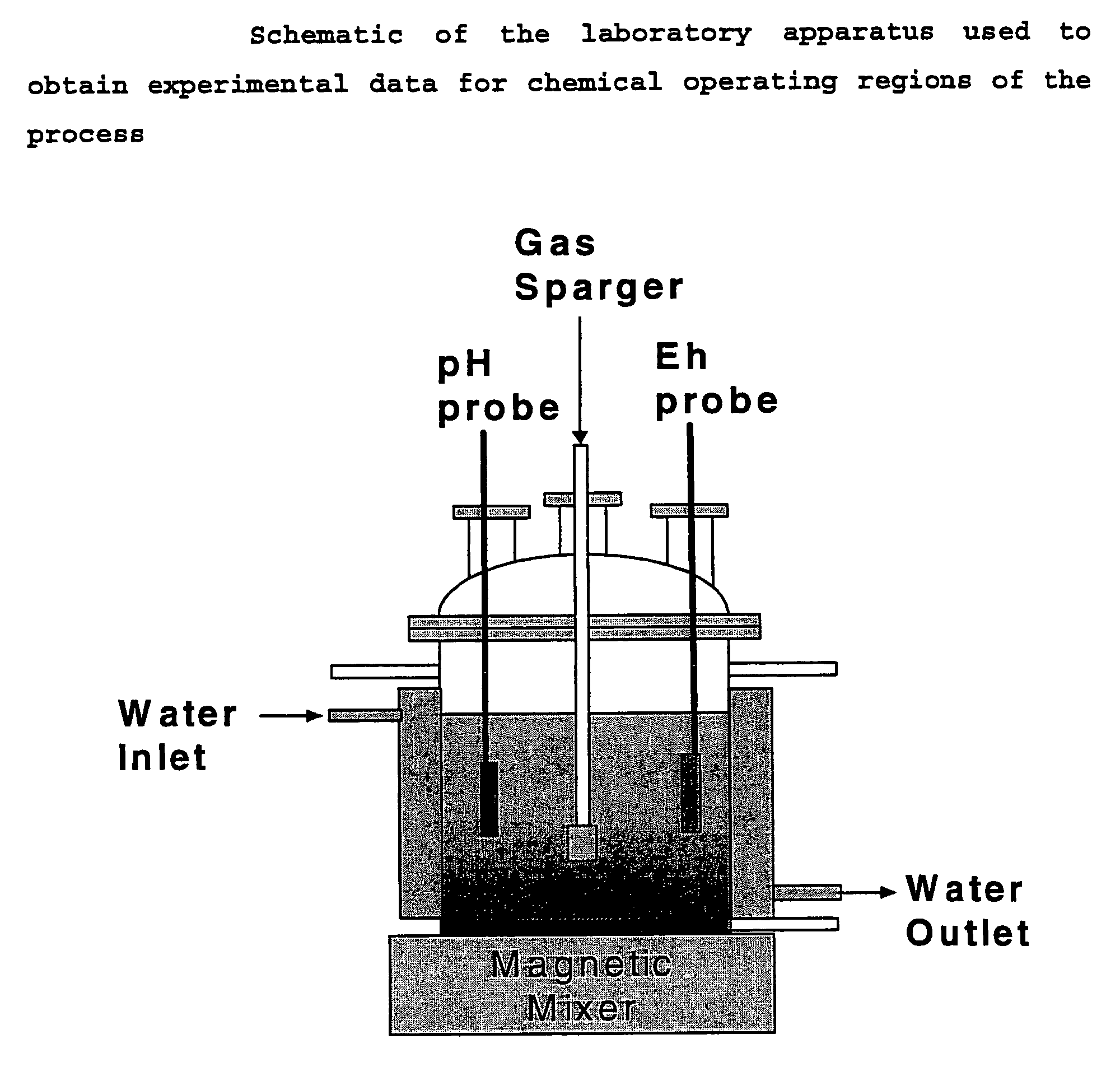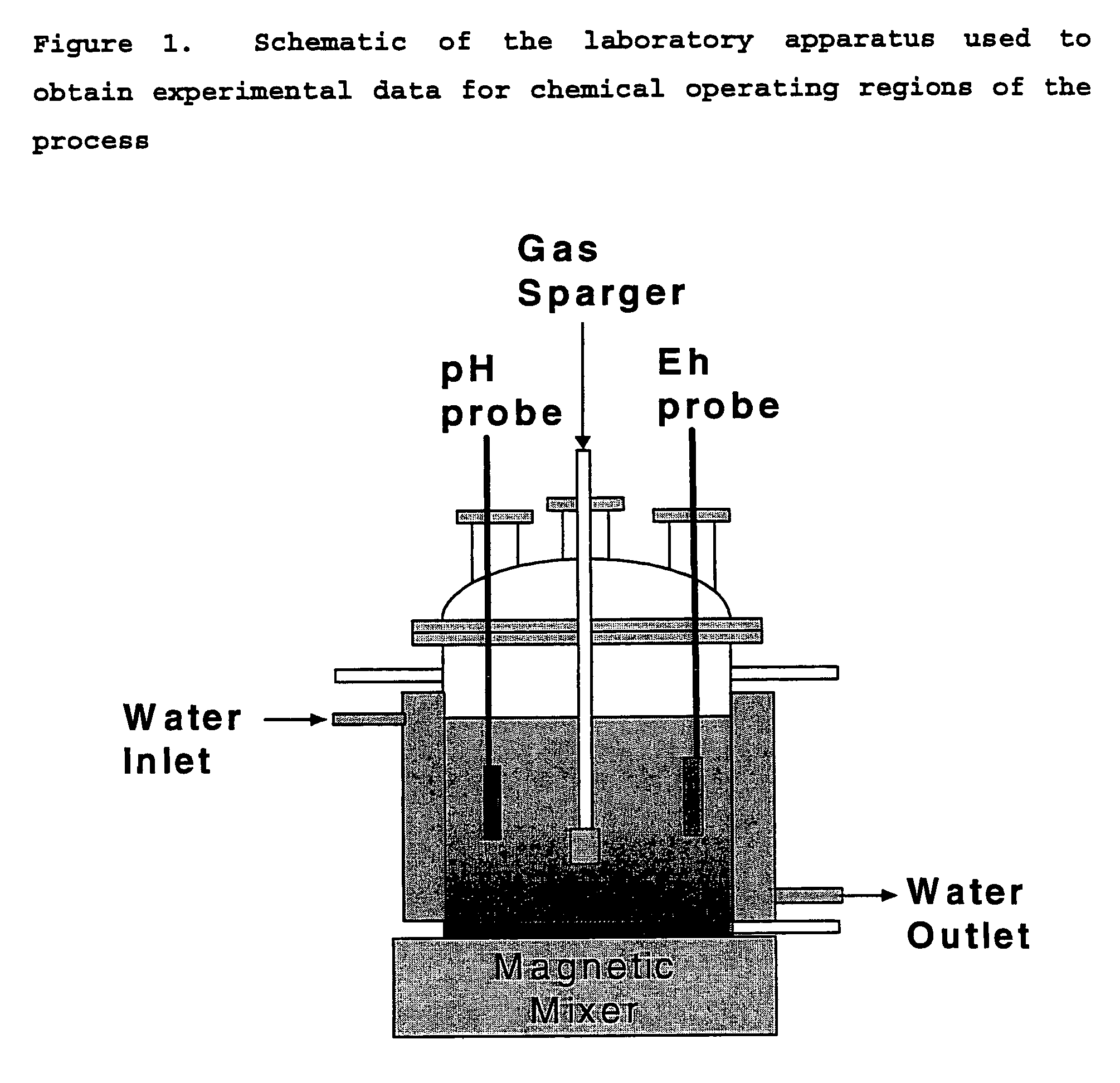Process for the purification of acidic metal-bearing waste waters to permissible discharge levels with recovery of marketable metal products
a technology of waste water and acidic metal, which is applied in the direction of water/sewage treatment, separation process, multi-stage water/sewage treatment, etc., can solve the problems of acid mine drainage (amd), continuous problem, and residual effects of metals and their use, especially in aqueous streams, so as to prevent the plugging of the membrane pores
- Summary
- Abstract
- Description
- Claims
- Application Information
AI Technical Summary
Benefits of technology
Problems solved by technology
Method used
Image
Examples
experiment 1
Batch Precipitation Process
[0079]This process and subsequent experimental study was conducted to establish the precipitation conditions required to obtain high purity precipitates from acid mine drainage. FIG. 1 shows a schematic of the batch precipitation process.
[0080]Feed water is pumped into a reservoir, then pumped to a reactor 10. The left-hand side of the reactor is where the primary reaction takes place. Upon addition of hydrogen sulfide to Berkeley Pit water at the proper conditions, metal sulfides were precipitated from the water. A mixture of hydrogen sulfide and carbon dioxide gas (to simulate the product of SRBs) was bubbled into the solution through a gas sparger 12 (which simultaneously provides mixing for the reaction). The Eh probe 14 and pH probe 15 are used to control the Eh and pH of the solution during the reaction. A pH controller and pump maintain the solution at the desired pH for precipitation by addition of sulfuric acid (3.70 M). The right-hand side of the...
experiment 2
Batch-Wise Selective Precipitation Experiment Using Hydrogen Sulfide
[0089]In this experiment, the tests were conducted batch-wise sequentially rather than simultaneously. The AMD was blanketed under argon gas and stirred continuously. The precipitation was conducted in batch-wise stages, using the filtrate liquid from the previous stage.
[0090]The pH at each stage was adjusted before precipitation using a caustic solution, either sodium or potassium hydroxide. The pH values selected for each batch stage are given in Table 6. Once the correct pH value had been obtained, the AMD solution was introduced into a hermetically sealed apparatus that provided capabilities for measuring the pressure of the head space, the removal of gas from the head space, and the introduction of hydrogen sulfide gas from an external source. Caustic was used as the precipitating agent in the aluminum removal stage.
[0091]The head space within the reactor was then evacuated by the vacuum pump. Once evacuated, t...
experiment 3
Studies on Membrane Precipitation
[0099]Although metals can be precipitated as sulfides using hydrogen sulfide gas, either alone or in a mixture, there are several problems associated with using sparged gas. These problems include the following issues.[0100]1. The unused hydrogen sulfide gas must be recycled into the precipitator, which requires a recycle compressor.[0101]2. The use of a recycle compressor introduces high investment and operating costs for the mechanical equipment because hydrogen sulfide is a corrosive gas.[0102]3. It is critical to control the rate of hydrogen sulfide gas dissolution in water and subsequent reaction with the metal sulfates to form insoluble sulfides that are of sufficient size to settle rapidly. In a sparged system, it is difficult to control the addition of hydrogen sulfide gas in stoichiometric or controlled amounts to the acid mine drainage liquid, since the usual method is simply to bubble the gas through the liquid.[0103]4. The formation of co...
PUM
| Property | Measurement | Unit |
|---|---|---|
| concentration | aaaaa | aaaaa |
| surface area | aaaaa | aaaaa |
| pressure | aaaaa | aaaaa |
Abstract
Description
Claims
Application Information
 Login to View More
Login to View More - R&D
- Intellectual Property
- Life Sciences
- Materials
- Tech Scout
- Unparalleled Data Quality
- Higher Quality Content
- 60% Fewer Hallucinations
Browse by: Latest US Patents, China's latest patents, Technical Efficacy Thesaurus, Application Domain, Technology Topic, Popular Technical Reports.
© 2025 PatSnap. All rights reserved.Legal|Privacy policy|Modern Slavery Act Transparency Statement|Sitemap|About US| Contact US: help@patsnap.com



